
Dahlia Experiments 2025 - Source Books For Dahlia Growing and Hybridising
Hello friends,
As you've probably already figured it out by now, I love doing gardening experiments. Whether it be growing my own wheat, and then harvesting that flour to bake into my own bread, or growing my own linen plants so I can spin and then weave the fibre from it, I'm curious about how the world works, and especially how plants work. This mostly comes from the fact that I'm a trained scientist, I have a PhD in Plant Biochemistry, and also a certificate in Horticulture. From a very young age, while gardening with my grandfather and aunt in their backyard, I fell in love with plants, and I decided I wanted to work with them.
Even though I am no longer in these fields of work, I still love learning about plants, and I use my garden as an experimental testing ground to do this on a very small scale. This, combined with my obsession and love of dahlias, I've decided that this growing season is going to be the one where I hone my dahlia skills including growing hybridised seeds from scratch, taking my own cuttings, and also breeding new dahlias from dahlias I already have growing in my garden.
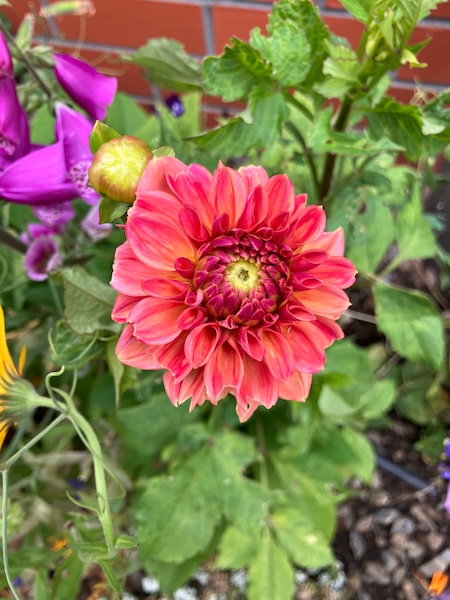
To do this my first job has been to find good source material to work from. Even though there is a tonne of information about dahlia growing and hybridising on the internet, it's hard to know what information is accurate, and what information is incorrect. Luckily there are some very good source books available from growers and hybridisers I trust, and I now have three books from them at my disposal.
First up is Erin Benzakein from Floret Flower Farm, her work with dahlias and other plants like zinnias is legendary, and her book "Discovering Dahlias" has been my go to dahlia book for years. It includes understanding dahlia types, how to grow, store, and divide dahlias, and also advanced techniques including propagating and hybridising dahlias. Her book also includes a great section on floral designing with dahlias, along with a visual section of her favorite dahlias sorted by colour. I really recommend this book to any new dahlia grower.
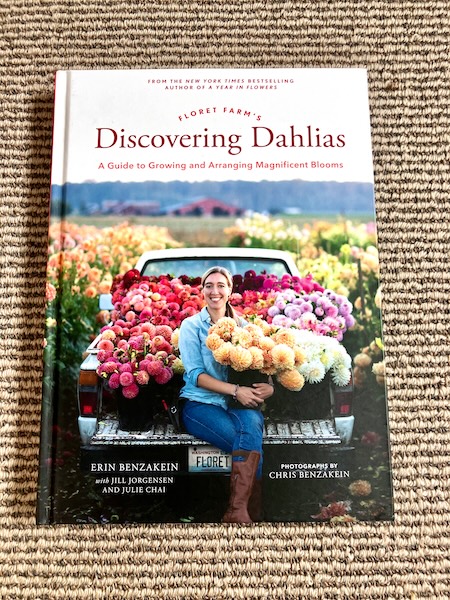
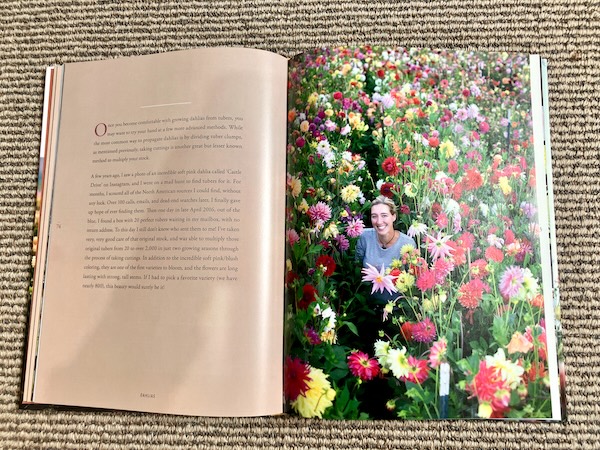
The last two dahlia source books I now own are by Kristine Albrecht, the owner of Santa Cruiz Dahlias. Her long term work on dahlia breeding, and her deep dive into dahlia genetics (which she is willing to share), makes her a fountain of knowledge about dahlias. Her book "Dahlias: Seed to Bloom" is an in depth guide to dahlia growing from seed to bloom. This is a great companion book to "Discovering Dahlias", and I now use them both side by side.
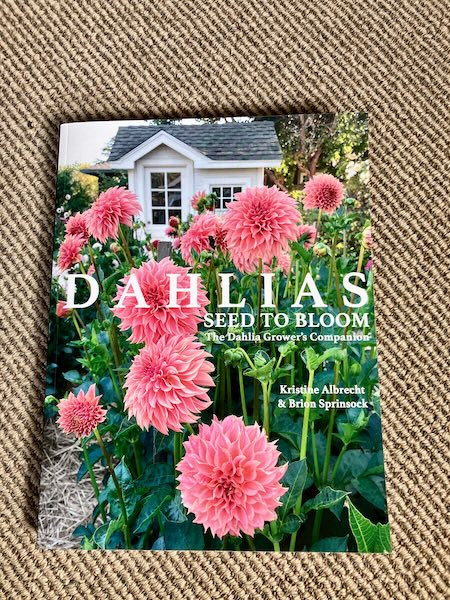
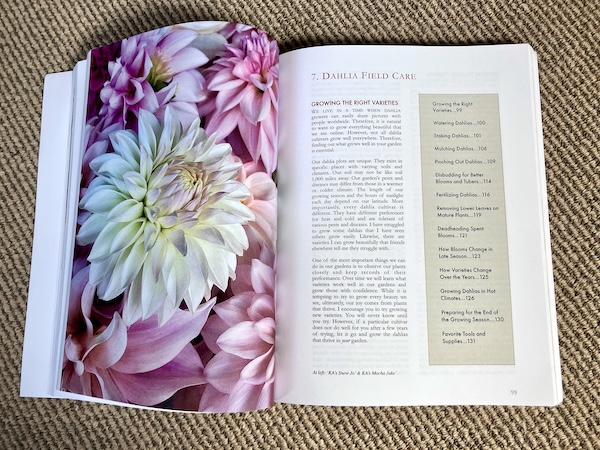
Kristine Albrecht's second book "Dahlia Breeding for the Farmer-Florist and the Home Gardener", is a small, but dense step by step guide to hybridising new dahlia varieties by seed. Its sections on dahlia genetics, traits to target in dahlia breeding, and growing dahlia seedlings, is perfect for the dahlia enthusiast interested in dahlia breeding. It was also really great to see her record keeping set up as well, as detailed notes are needed to decide whether a dahlia seedling has the traits you are looking for in the first year, and in the continuing years, if you decide to keep growing it.
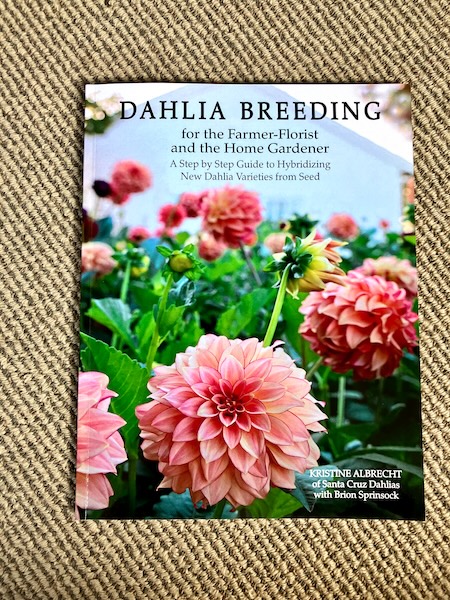
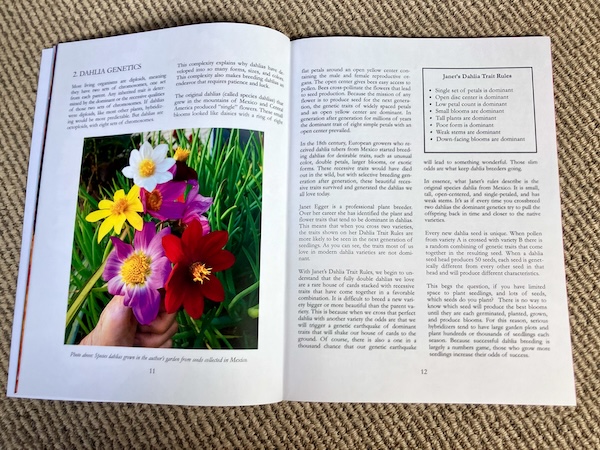
With spring now sprinting towards summer with each passing day, and the first of my garden dahlias are popping their leaves above ground, I can't wait to dive into all things dahlias this growing season.
Have a wonderful day
Julie-Ann
Want to discuss my post? Feel free to chat with me on Instagram or Mastodon or Bluesky.
Frederick the Literate Cross Stitch Project
Hello friends,
I recently began a new cross stitch project, Frederick the Literate, by Dimensions. This cross stitch kit has been a unicorn project of mine for years, but until recently I haven't been able to get hold of a copy of my own. When I usually try to track it down, it's always out of stock in New Zealand.
Luckily one of my sister's found it available on Spotlight's website, and it was on special, so I bought it immediately before it sold out. After waiting for what felt like forever, and dealing with courier issues (who nearly lost it), I cracked the kit open and got started.
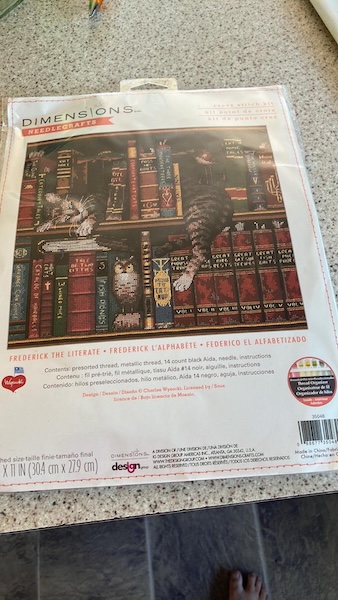
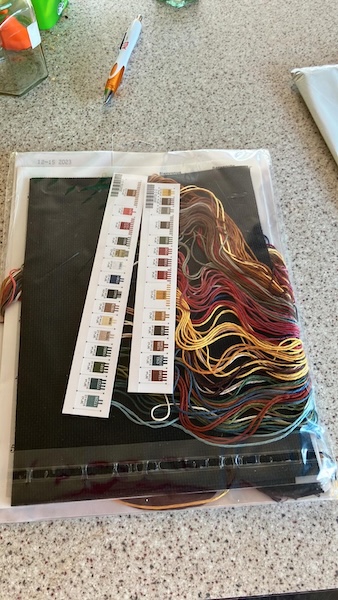
The kit contains two of my favorite things, cats and books, so I was especially excited to start stitching, even though the background aida was black in colour...
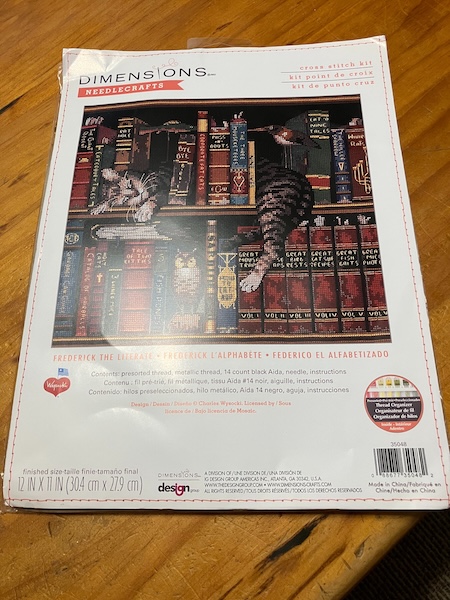
As typical with Dimensions kits, the thread was on cards, so I used a hole punch to make space for threads in progress. And since Dimensions often use combined threads, I had to come up with a plan to deal with these mixed threads as well.
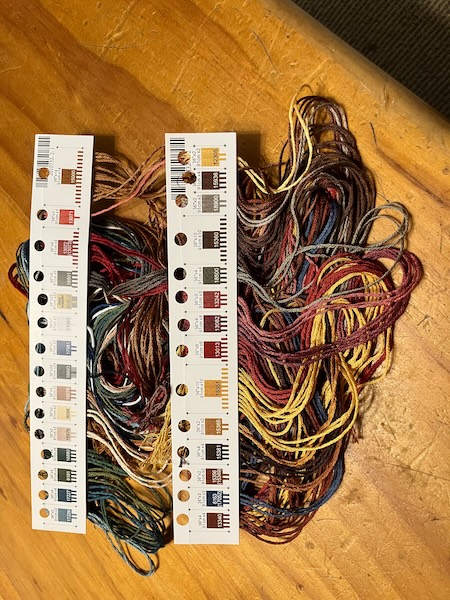
And this is my progress with Frederick the Literate cross stitch project so far. The books on the top row, in the middle, are in progress. I never do any back stitching on a project until the end, so right now the books are looking pretty blocky. It won't be too long though before I start cross stitching the cat, which I'm excited about.
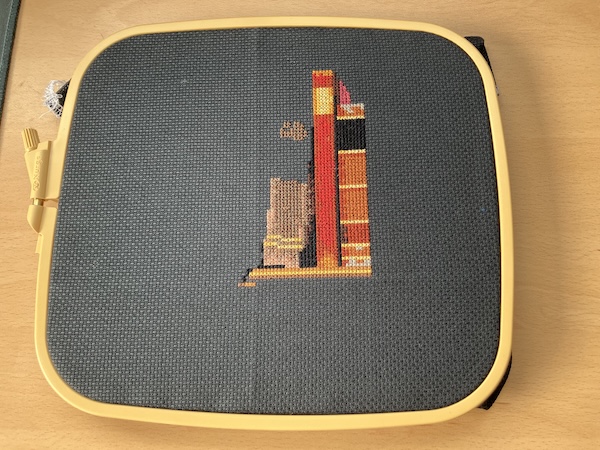
Luckily this cross stitch project isn't too big, so it won't take too long to complete over the coming months of autumn and winter.
Have a wonderful day
Julie-Ann
Want to discuss my post? Feel free to chat with me on Instagram or Mastodon or Bluesky.
Growing and Harvesting European Linen for the 2023-2024 Season
Hello friends,
As a crafter and a gardener, I like to combine my hobbies in interesting ways. In this case it was growing and harvesting European flax (Linum usitatissimum) in order to prepare some linen for spinning and weaving.
Back when we lived in Wellington I bought some Essene European flax seed (Linum usitatissimum) from Koanga Gardens. In the first year I sowed half the seed packet into a 1 m x 2 m space, and grew the linen plants mainly for producing seeds, so in years afterward I could grow even more flax for linen. My linen harvests thereafter would be self-sustaining. I now grow linen every couple of years for collecting seeds, and stockpiling flax stalks for making linen.
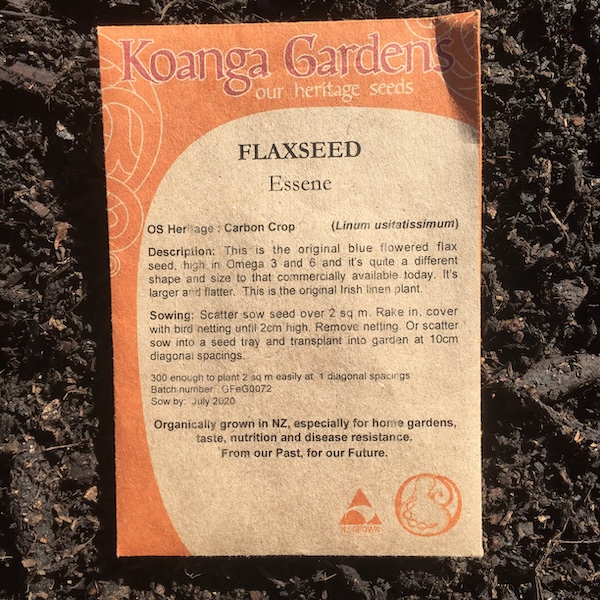
This blog post is showing the process of growing linen from seed sowing to harvesting. In later blog posts I'll share as I go through the flax processing and then spinning and weaving it.
The first thing I did was buy the book "Homegrown Linen: Transforming flax seed into Fiber." by Raven Ranson. This book is very detailed, and shows all the necessary steps in growing homegrown flax for linen. I then used it to calculate how to grow it in New Zealand seasons.
The first step in growing flax seed is deciding when to sow the seed. Flax seed is sown in spring when oats and barley are sown, and in our case it was in mid-October. If flax is grown for linen then the seeds are grown very close together so that long tall stalks are produced, but if flax are grown for seeds, they are planted further apart to allow for branching and more flower production.
After weeding the patch of ground it was to go into in spring last year, I fertilized it with a high nitrogen fertilizer in the form of sheep pellets, and then prepared the soil to a fine tilth. I then sowed the flax seed in a broadcast fashion very close together, so that the linen plants would grow very tall, with little to no branching. After covering the seeds over with a fine layer of soil using a rake, I watered the seeds in, and then covered the crop with bird netting to protect the seeds from the local very hungry avians. It takes approximately 100 days from seed sowing until plant harvest, so this was classed as day 0.
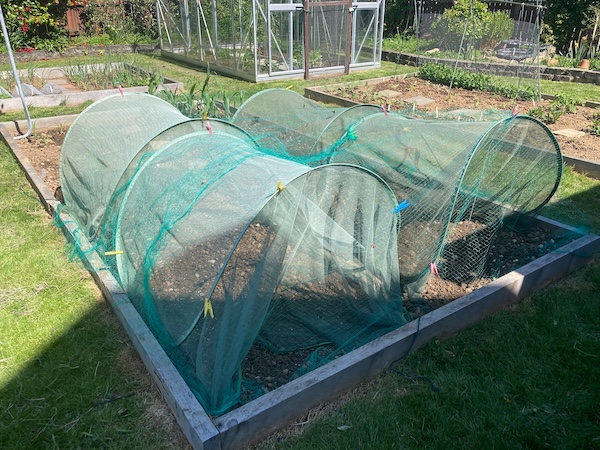
Within a few days of watering each day, the flax seedlings began to appear. It is always very exciting to see them come up.
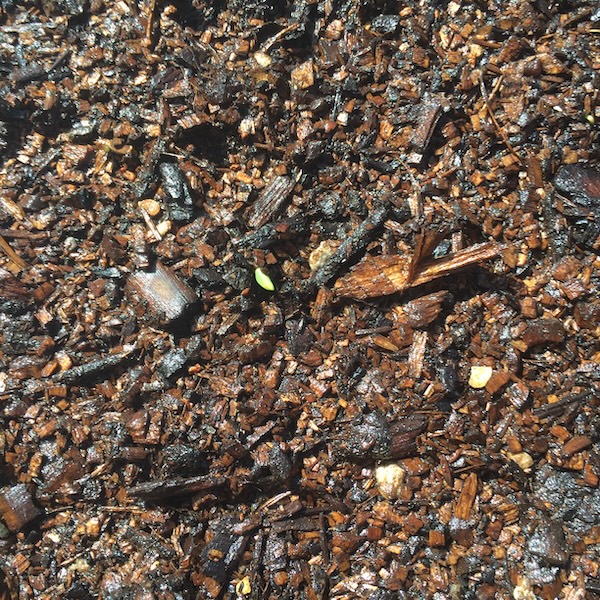
And within a week, the seedlings were actively reaching for the sky. In the photo below I was growing the linen plants for seed, but as you can see, I spread them a little too far apart.
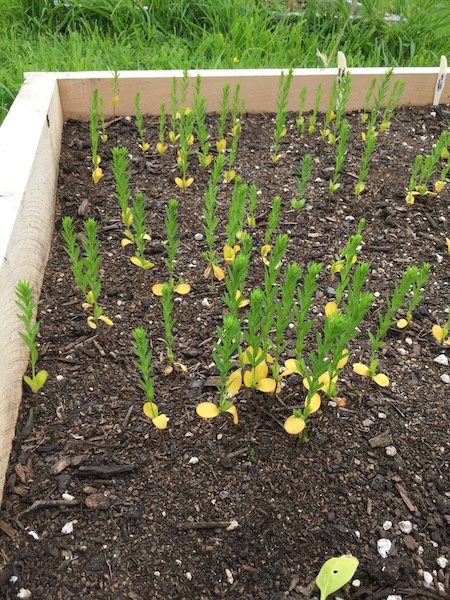
Once the flax starts growing, it basically fends for itself. If sown very close together no weeds will grow, making it an easy crop to take care of, as long as it gets enough water. And once the flax reaches about 50 cm tall, it begins flowering at around day 60. The beautiful blue flowers open during the day, and close again at night. And now that the plants are tall, they sway very prettily in the breeze.
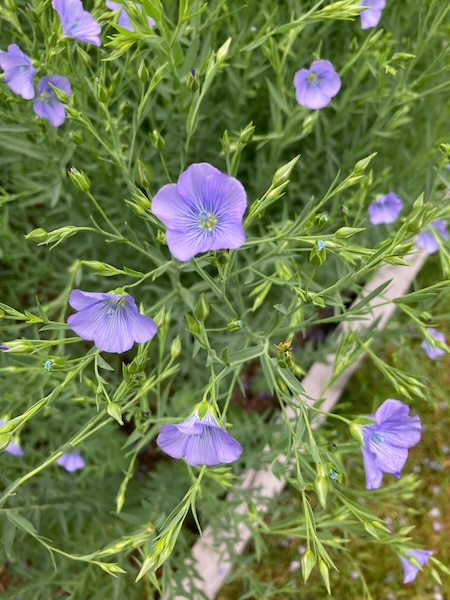
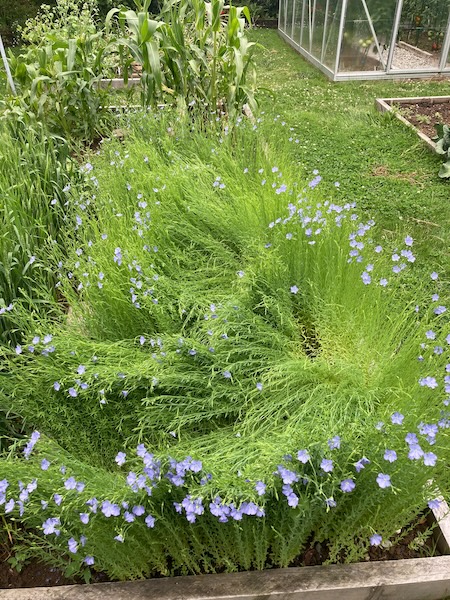
Flowering and setting seed boils takes around a month. One of our neighbourhood cats, who we call Patches, decided to make their snoozing spot inside the linen crop. No matter how many times I tried to shoo them away, they kept coming back, so I let them be. It's a good thing they're cute because they ended up squishing a bunch of linen...
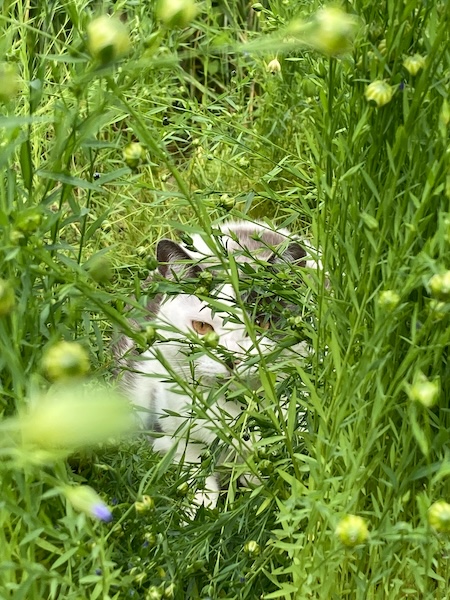
Once the seed heads (boils) have set, now is the time to think about when to harvest. It's a good idea to set aside a section of your crop to let the boils (seed heads) mature and turn brown, which means they are then ready to harvest for next years seeds. Their plant parts will be dry and thick and yellow, and they won't make good linen.
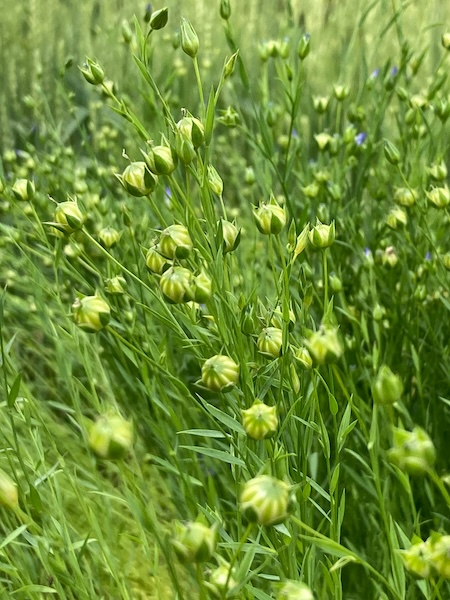
The rest of your crop will be used for producing linen. When the bottom half the plant has turned golden, it is time to harvest the plants. The seed heads will not usually be viable for collecting seed, but I've found in the past that some of them can be.
The best way to harvest linen is to pull them out by hand in clumps. Lay the harvested linen plants out on the grass, all facing the same way, with the roots at one end, and the boils at the other. Once you've harvested all the linen plants, it's time to stook the plants, which means creating bunches of sheafs, and then tying them in the middle like the poles of a teepee. You want air to get up into the middle of the sheaf to dry it out. Place the sheafs upright with the roots at the bottom and let them dry in the sun on sunny days.
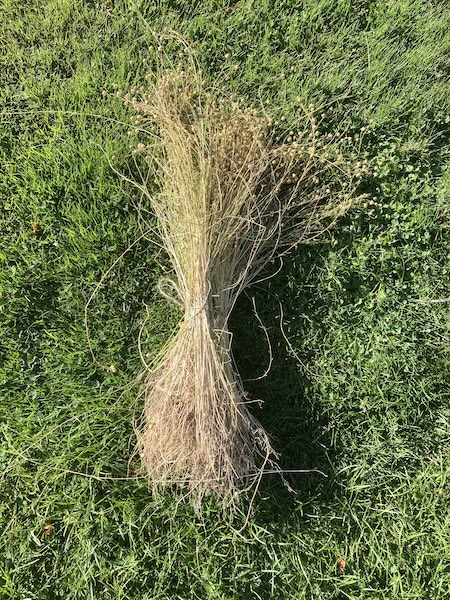
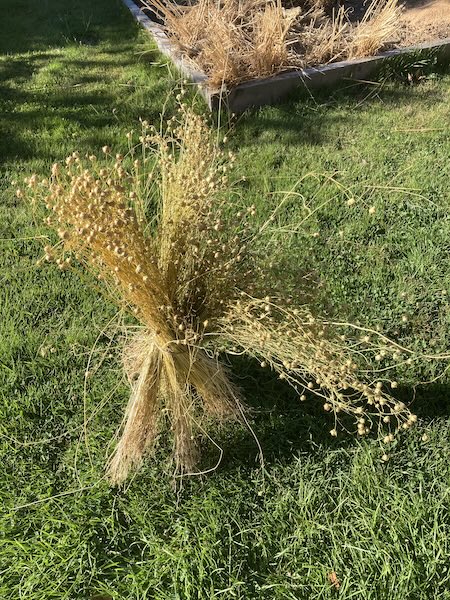
Once the linen plant sheafs are dry you can store them until you want to begin processing your linen. The next step is processing my current linen crop, and this will occur in a couple of weeks after autumn starts...
Have you ever tried experimental gardening? I've done this in the past with growing wheat, and it's very interesting to see how food and fibers are processed. It makes you appreciate how complicated food and textile production is.
Have a wonderful day
Julie-Ann
Want to discuss my post? Feel free to chat with me on Instagram or Mastodon or Bluesky
Staying at SkyScape in Twizel for our Wedding Anniversary
Hello friends,
Recently it was hubby and my wedding anniversary. It was a big anniversary, the type of one that has precious metal connotations with it.
It's hard to believe it's been 25 years. Hubby and I met in university, back when I was a biochemistry honors student, and he was in 3rd year computer science. We met through a mutual friend, and then over time we became best friends, and then we started dating after falling in love. After a couple of years, we got married, and life has been busy ever since.
We decided for our 25th wedding anniversary we wanted to do something very special, and since I have developed a very large fear of flying (thanks to living in Wellington), we decided to stay somewhere within driving distance.
A number of months earlier I had spotted an Instagram ad for a place in the Mackenzie region called SkyScape. It's a luxury eco-accomodation nestled within tussocks and hillside of Omahau Hill Station. Once I showed hubby that we could have an opportunity to sleep under the stars within the dark sky reserve, similar to places like Finland and Iceland, we booked our stay.
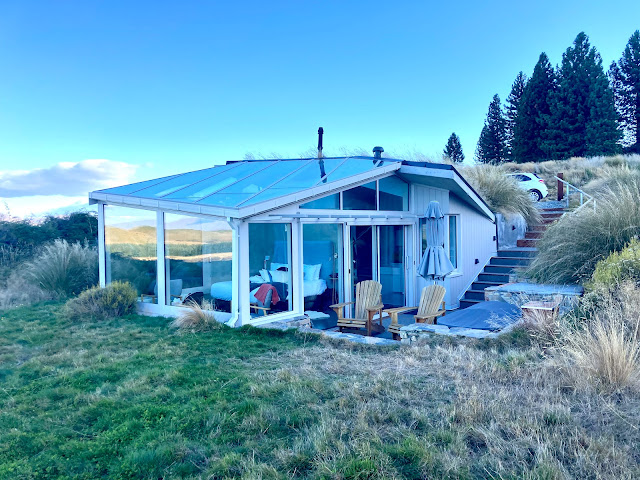
The
day before our anniversary we drove from Dunedin to just outside of
Twizel, where SkyScape is based. The three SkyScape units are nestled in
the hills on a working farm just before the mountain called The
Pyramid. Each of the units are far away from each other, ensuring
privacy and peace. After settling in, enjoying the central heating on
the cool autumnal day, and cooking a delicious meal, we eagerly awaited
nightfall.
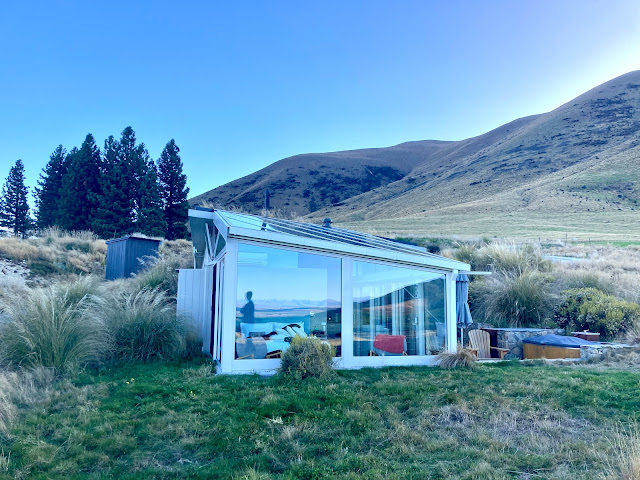
We were extra excited because my phone had been pinging me all day about there being a huge aurora. A KP8 aurora was happening, and we hoped and prayed it would last until I could photograph it. As a keen amateur astro-photographer I had brought all my gear, it was a great chance to do some photography. We prepped my camera gear, got out all our winter clothes and hiking boots, and waited... And oh wow, it was just wonderful, the aurora was huge and big and bright. While taking photos hubby and I witnessed arcs, bands, and rays, all visible to the naked eye.
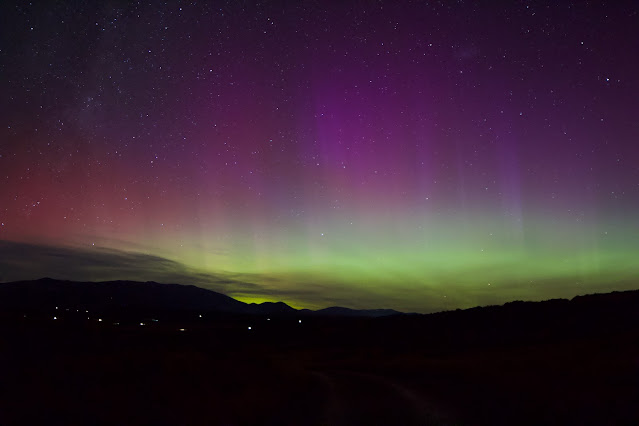
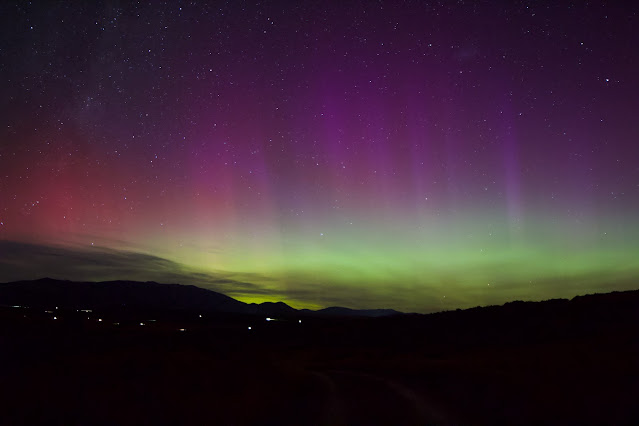
The aurora was so beautiful and magnificent, it didn't really bother us that it was freezing outside. We stood outside taking photos for a couple of hours, and then once the aurora had begun to disappear, we retreated back to the cozy warmth of our SkyScape unit, and looked up at the milky way through the glass roof above us.
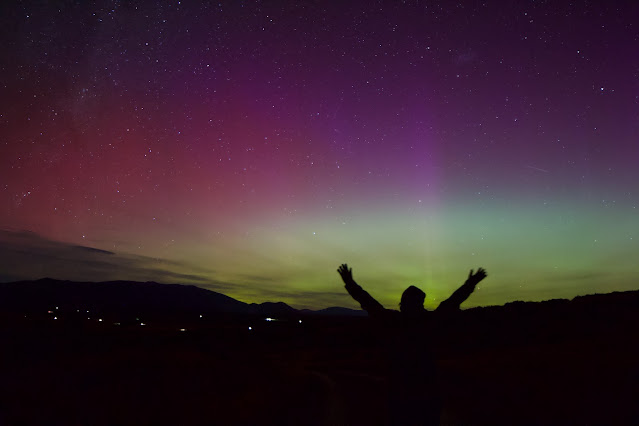
It
was very special to be going to bed and sleeping under the stars, I
actually found the whole experience very relaxing during the night
whenever I woke up. The
next morning, our wedding anniversary, the sun peeked out over the
horizon, and we were treated to the most amazing sunrise from the
comfiness of our warm bed.
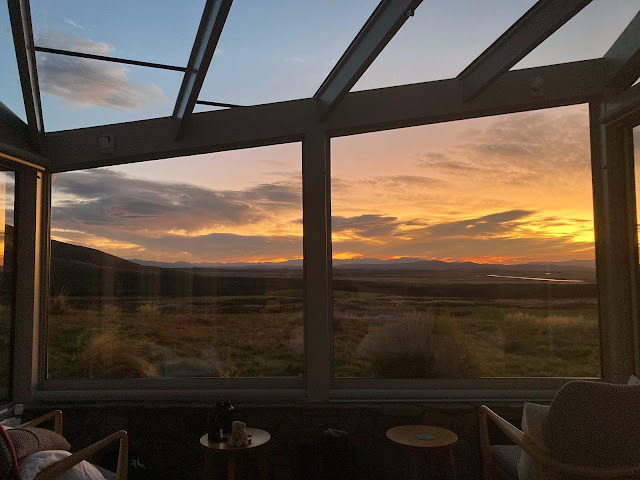
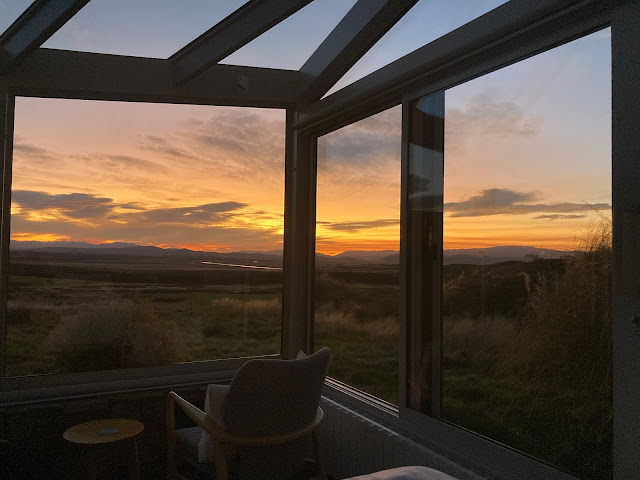
The next few days were quiet and restful, since I was recovering from surgery, and then an infection afterward. We relaxed, read books, I did knitting and cross stitch, and we ate lots of good food. Hubby went for walks on the farm tracks, since I wasn't allowed to be doing that much exercise yet, and he also enjoyed SkyScape's outdoor tub as he soaked under the stars. I'd downloaded TV shows and movies on Netflix and Disney+ on my iPad before we left home, since I knew there was no TV available, and we ate popcorn and snuggled up as we watched shows on my small iPad. We also went into town for supplies, and to walk around, and we found the most amazing bookstore in Twizel called The Twizel Bookshop. The bookstore is tiny, but the owner has the most amazing taste in books. I walked away with a pile of books I'd been wanting for ages, but couldn't find them easily in our local bookstores. They had a great selection of science, gardening, fantasy, and science fiction books for both children and adults, and I'll definitely order from them online in the future.

While we were also in town, I found this amazing giftware store, and I just had to come home with a bee themed mug called "Bee Happy". It got added to my huge mug collection that hubby groans about at every time he opens the kitchen cupboard.
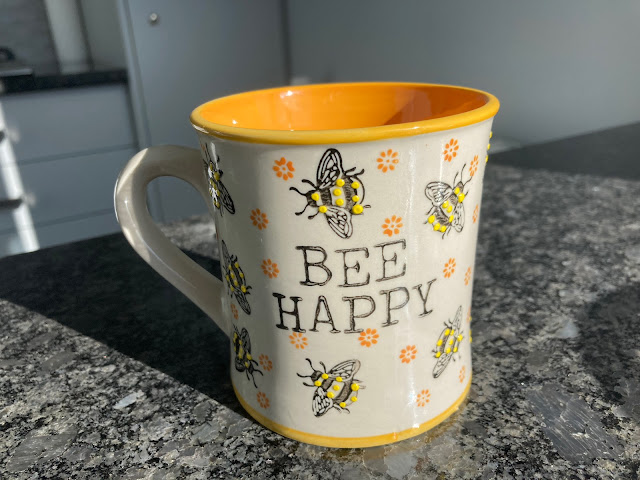
On our last night we went into Twizel for dinner, and came across the institution that is Twizel's Chippery. We waited for our order in the car since it was already getting cool, and drove to a scenic spot to eat dinner while the sun was going down behind the mountains. We headed back to SkyScape very soon after that, a frost was due, and we wanted to return while it was light enough to easily drive the long farm track to the unit.
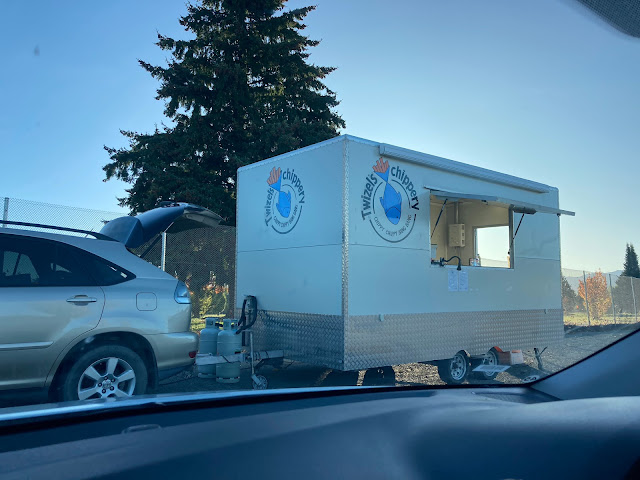
The next day, we left SkyScape and Twizel, happy and relaxed, and we headed north for the next part of our adventure, visiting Aoraki, and then onto Lake Tekapo. I hope you've enjoyed hearing about our adventure, if you ever get the opportunity to go to somewhere like SkyScape, I thoroughly recommend it. Our hosts were friendly and knowledgeable, and their units are wonderful to stay in. The units were designed to keep warm in winter, and cool in summer, and are solar powered. Water is supplied by a local spring. I really enjoyed their continental breakfasts while we stayed there.
Have a wonderful day
Julie-Ann
Want to discuss my post? Feel free to chat with me on Instagram or Mastodon.




